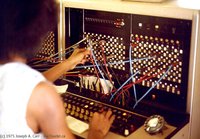Telephone switchboard
|
|
A switchboard is a device used to manually connect a group of telephones from one to another or to an outside connection. The user is typically known as an "operator".
The device is usually designed to enable the operator to sit at it. It has a high backpanel which consists of rows of female jacks, each jack designated and wired as a local extension of the switchboard (which served an individual subscriber) or as an incoming or outgoing trunk line. The jack is also associated with a lamp. On the table or desk area in front of the operator are columns of keys, lamps and cords. Each column consists of a front key and a rear key, a front lamp and a rear lamp, followed by a front cord and a rear cord. The front key is associated and wired to the front cord and the rear key is associated with and wired to the rear cord. Each of the keys has 3 positions - back, normal and forward. When a key is in the normal position an electrical talk path connects the front and rear cords. A key in the forward position connects the operator to the cord, and a key in the back position sends a ring signal out on the cord. Each cord has a 3-wire connection -tip and ring; for testing, ringing and voice; and a sleeve wire for busy indications. When a call is received, a jack lamp lights up on the back panel and the operator responds by placing the rear cord into the jack and throwing the rear key forward. The operator now converses with the caller and finds out where the caller would like to be connected to. If it is another extension, the operator places the front cord in the associated jack and pulls the front key backwards to ring the called party. After connecting, the operator leaves both cords "up" with the keys in the normal position and the parties can converse.
Switchboards came into use shortly after the invention of the telephone in 1876. Small towns typically had the operator's switchboard installed in the operator's home so that she could answer calls on a 24 hour basis. New England Telephone and Telegraph installed the first battery-operated switchboard on January 9, 1894 in Lexington, Massachusetts.
Large city switchboards usually were mounted floor to ceiling and the operators were boys who could scoot up a ladder to connect to the higher jacks. The boys were replaced by women because it was found that boys had little patience and would frequently curse the customers. Operators were almost always women until the mid 1960's when men were once again hired. Manual switchboards have for the most part been replaced by more sophisticated devices or even personal computers, which give the operator access to an abundance of features.
See also
External link
- Play a switchboard game (http://www.connectedearth.com/FunandGames/Games/Howdoesaswitchboardwork/index.htm)

